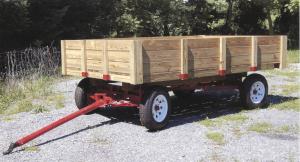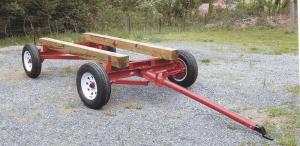2011 - Volume #35, Issue #1, Page #35
[ Sample Stories From This Issue | List of All Stories In This Issue | Print this story
| Read this issue]
Old Running Gear Converted To Sturdy Hay Wagon
 |
 |
Creswell made his living as a computer systems engineer but now lives on a small acreage. He uses the wagon to give hay rides to his grandchildren "and to any adults who want to relive their youth."
A fellow member of an antique farm machinery club gave the rusty old running gear to Creswell. The running gear had been sitting in a farm field for two years. However, it had minimal surface rust, and the welded joints were still in good shape. The tires, though, were trashed.
"It was a homemade running gear, and no one seemed to know if it had been used as a grain wagon or what," says Creswell. "The wheels and hubs were off an old car, but I didn't know what kind. The tie rods were so badly corroded that I could hardly turn the bolts, so I started looking for new tie rod ends."
First he went to a local auto shop. "They had all kinds of tie rod ends but none matched. The manager looked through lots of catalogs but he couldn't find anything."
Then Creswell searched the internet and found Gary Blakemore's eBay store called "cruisinautoparts" (email address: glblakemore@sbcglobal.net). He sells all kinds of antique car and truck parts. "He asked me to send him the exact size of the threaded bolts and the dimensions. He figured out that the wheel hubs on this running gear came from a 1955 Ford car. I bought both tie rod ends from Blakemore for only $19 û a very good price. All the parts he sells are original and made in the U.S. In fact, the tie rod ends he sold me were still in the original box."
A pair of 6-in. sq., 8-ft. long wooden beams support the wagon bed. Creswell used 1/2 by 10-in. galvanized bolts to attach the beams to the frame.
The wheel rims and tires that came on the running gear were "a mess".
"The front tires had 15-in. rims but the rear ones 17-in. rims, so I threw all of them away and bought new tires and rims from Tractor Supply Co. The 5-stud bolt pattern on the wheel hubs matched the 1955 vintage car hubs perfectly," says Creswell.
He used 5 1/2-in. wide, 3/4-in. thick, pressure treated deck boards and coated deck screws to build the wagon's sides and floor, and screwed the floor down solid to the running gear's cross beams. He bolted metal stake brackets onto the sideboards for the stakes, and also screwed the stakes onto the sideboards. The corner posts are 2 by 4's secured to a 4 by 4 base.
He modified a Reese hitch and attached it to fit the wagon's round tongue. The hitch's edges were ground off round so the hitch can slide into the tongue.
To clean up the running gear he wire brushed the frame by hand and then applied Rust Reformer, which was followed by two coats of heavy-duty truck paint.
There's a bench and backrest on front of the wagon. Loose straw is placed elsewhere.
Tailgate boards on back of the wagon slide into slots. "I just lift the boards out and then place a small stepladder to provide access to the wagon. I may add a ladder in the future."
The fully assembled wagon is built solid and rigid. "Everyone who rides in it is amazed at how sturdy it is," notes Creswell.
Contact: FARM SHOW Followup, Doug Creswell, 16401 Camalo Dr., Mount Airy, Md. 21771 (ph 410 489-5832; doug.creswell@ieee.org).

Click here to download page story appeared in.

Click here to read entire issue
To read the rest of this story, download this issue below or click here to register with your account number.




